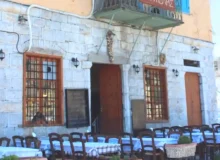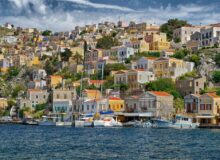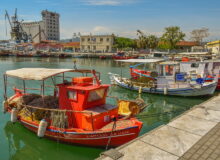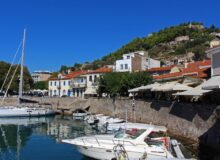The See Greece guide to the island of Tilos with a brief history and travel information on how to get there by ferry or by air and what to see and do.

Introduction to Tilos
Tilos is a small, unspoiled island in the Dodecanese, known for its rugged landscapes, pristine beaches, and rich history. Unlike some of its more tourist-heavy neighbors, Tilos offers a peaceful retreat with a strong commitment to sustainability and eco-tourism. Whether you’re interested in hiking through wildflower-covered valleys, exploring medieval castles, or relaxing on secluded shores, Tilos provides an authentic Greek island experience.
Where is Tilos Located?

Tilos lies in the southeastern Aegean Sea, between the larger islands of Kos and Rhodes. It is part of the Dodecanese group, which also includes popular destinations like Patmos, Symi, and Leros. Despite its modest size—just 61 square kilometers—Tilos boasts a diverse terrain of mountains, fertile plains, and dramatic coastlines.
A Brief History of Tilos
Tilos has a long and fascinating history, dating back to ancient times. Archaeological findings suggest the island was inhabited as early as the Neolithic period. In antiquity, it was known for its thriving trade and was even mentioned by Homer in The Iliad.
During the medieval era, the Knights of Saint John fortified Tilos, building castles to protect it from invaders. Later, the island came under Ottoman rule before being occupied by Italy in the early 20th century. Tilos officially became part of Greece in 1948, along with the rest of the Dodecanese.
One of the island’s most intriguing historical aspects is the discovery of dwarf elephant fossils in the Charkadio Cave, proving that Tilos was once home to these unique creatures.

What to See and Do on Tilos
1. Explore the Charming Villages
– Megalo Chorio: The island’s capital, a traditional whitewashed village with narrow alleys and the ruins of a medieval castle overlooking the sea.
– Livadia: The main port and most developed area, with waterfront tavernas, shops, and a sandy beach.
– Mikro Chorio: A ghost village abandoned in the 1950s, now partially revived with a single bar that attracts visitors at night.
2. Visit Historical Sites
– The Castle of the Knights of Saint John: Perched above Megalo Chorio, this fortress offers panoramic views and a glimpse into Tilos’ medieval past.
– Monastery of Agios Panteleimon: A 15th-century monastery with beautiful frescoes and a peaceful courtyard.
– Charkadio Cave: Where fossils of dwarf elephants were discovered—now an important paleontological site.
3. Relax on Stunning Beaches
– Eristos Beach: A long, sandy bay with calm waters, perfect for swimming and sunbathing.
– Plaka Beach: A secluded stretch of pebbles and clear water, ideal for a quiet escape.
– Agios Antonios Beach: A small, picturesque cove with a charming chapel nearby.
4. Hike Through Nature Trails
Tilos is a paradise for hikers, with well-marked trails leading through valleys, past abandoned farms, and up to scenic viewpoints. Popular routes include:
– The path from Megalo Chorio to the castle.
– The trail from Livadia to the monastery of Agios Panteleimon.
– The walk through the abandoned village of Mikro Chorio.
5. Experience Local Culture & Cuisine
Tilos has a strong farm-to-table tradition, with many tavernas serving locally sourced ingredients. Don’t miss:
– Fresh seafood at Livadia’s waterfront restaurants.
– Homemade honey and goat cheese from island producers.
– Traditional dishes like pitaroudia (chickpea fritters) and mizithra (local cheese).
Best Time to Visit Tilos
The best time to visit Tilos is between May and October, when the weather is warm and sunny.
– Spring (May-June): Ideal for hiking, with wildflowers in bloom and mild temperatures.
– Summer (July-August): Peak season, perfect for beach lovers, though still quieter than other Greek islands.
– Autumn (September-October): A great time for peaceful exploration, with warm seas and fewer crowds.
Winter is very quiet, with limited ferry connections and some businesses closed.

How to Get to Tilos
By Air
Tilos does not have its own airport. The nearest airports are:
– Rhodes International Airport (RHO): The most common gateway, with flights from Athens and European cities. From Rhodes, take a ferry (2-3 hours).
– Kos International Airport (KGS): Another option, with ferry connections to Tilos (1.5-2.5 hours).
By Ferry
Ferries are the main way to reach Tilos. Services operate from:
– Piraeus (Athens): A long journey (12-14 hours), usually overnight.
– Rhodes: Regular ferries (2-3 hours) with companies like Dodekanisos Seaways and Blue Star Ferries.
– Other Dodecanese Islands: Connections from Kos, Symi, Nisyros, and Kalymnos.
Schedules vary by season, with more frequent services in summer.





















